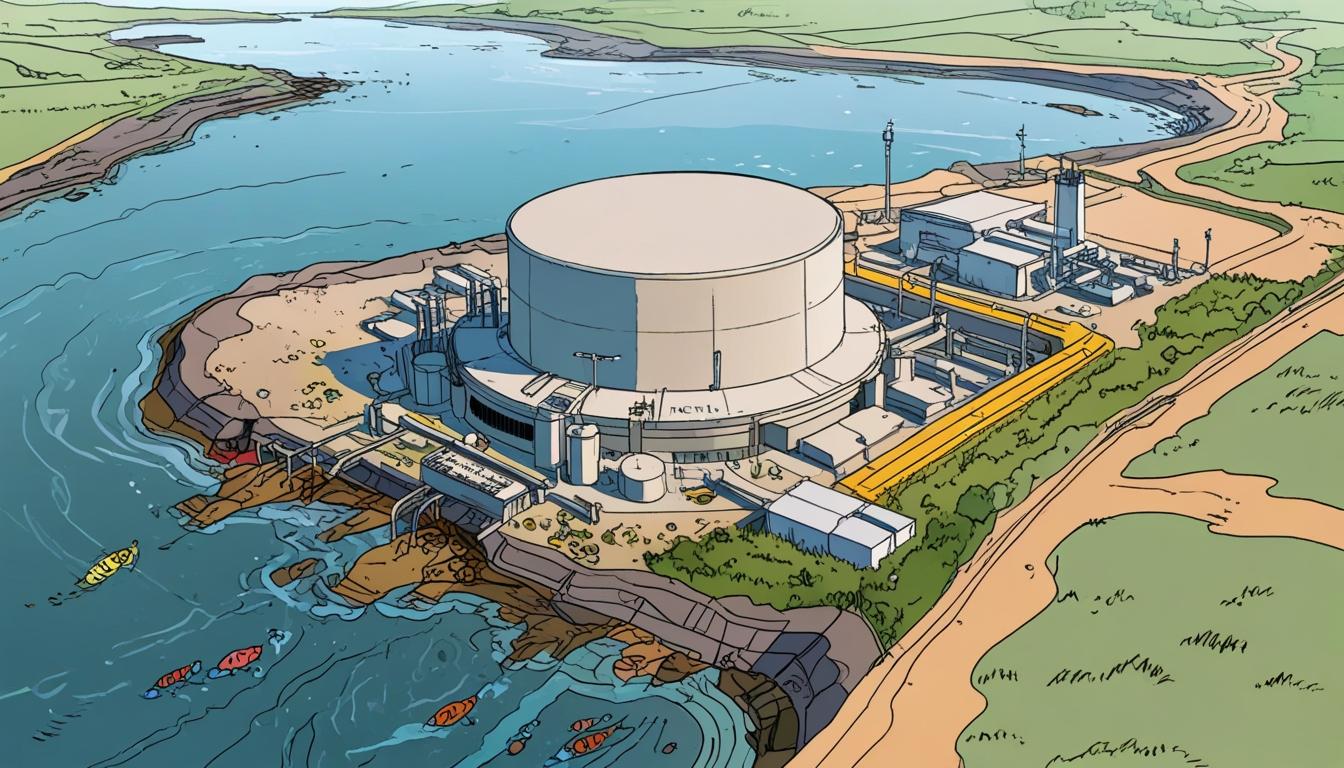Concerns arise over EDF’s acoustic deterrent at Hinkley Point C as UK grapples with balancing infrastructure growth and environmental safeguards.
Last month, the spotlight turned to the ongoing debate surrounding Hinkley Point C, the UK’s nuclear power station, and its controversial approach to marine life conservation. This situation has arisen from plans put forth by EDF, the French state-owned company overseeing the facility, to implement an ‘acoustic deterrent’ designed to protect aquatic organisms from being drawn into the plant’s cooling systems. The proposed method involves constant underwater noise for an estimated six decades, a move that has raised concerns regarding the impact on marine life and the surrounding environment.
The issues raised by the deterrent have highlighted broader challenges within infrastructure planning in the UK, where the balancing act between infrastructure development and environmental protection has become increasingly complex. Graham Thomas, Chair of the Rivers Trust, commented wryly on the situation, suggesting that EDF could “prevent murder on the dance floor” by adhering to its commitments for mitigating environmental impacts. This remark reflects a growing frustration among stakeholders regarding the potential consequences of such measures on local ecosystems.
Within this context, the UK Government is actively pursuing reforms through the Planning and Infrastructure Bill, published in March. This legislation aims to expedite the construction of significant energy projects by permitting the establishment of onshore wind farms on land owned by the Forestry Commission, marking a departure from previous restrictions. While these reforms are perceived as a positive initiative, experts assert that they alone are insufficient to address the encompassing issues of infrastructure resilience and performance.
Alongside the urgency of expediting these projects, the need for sustainable and long-lasting infrastructure has become a focal point for decision-makers. Key considerations include incorporating climate risk assessments into planning processes and ensuring that new infrastructure can adapt and withstand future challenges. Policymakers have been urged to recognise the interdependent nature of infrastructure systems, especially as highlighted by the recent incident where a substation fire temporarily shut down operations at Heathrow Airport, one of the busiest airports globally.
Emphasising a systematic and data-driven approach, experts argue for the integration of advanced digital technologies into infrastructure development. Establishing a centralised digital information framework that provides comprehensive data regarding infrastructure performance is deemed essential. This system would enable real-time monitoring through digital twins—virtual replicas connected to physical systems via sensors—which can significantly enhance the management and reliability of assets. By allowing for advanced scenario planning and issue detection, such technologies could prevent minor problems from escalating into major crises.
Furthermore, the construction and infrastructure sectors are facing a notable skills shortage. The 2024 Construction Skills Network report predicts that an additional 251,500 construction workers will be necessary by 2028 to meet anticipated demand. This situation highlights the imperative for industries to adapt by embracing digital methods to improve productivity and reduce construction timelines, necessitating not only traditional engineering skills but also expertise in data science and technology.
In light of these challenges, a coordinated strategy is necessary to develop sustainable infrastructure capable of meeting evolving societal needs. Long-term policy clarity is critical to promote investment in resilient projects and facilitate the establishment of regulatory frameworks that adapt to technological advancements. Without addressing these multifaceted elements, the UK risks failing to maximise its existing infrastructure and ensuring that new developments provide the reliability and adaptability essential for future energy demands.
Dave Philp, chief value officer at Bentley Systems in Advisory Services, emphasises the significance of integrating lifecycle and resilience-focused strategies to establish an energy sector that meets today’s demands while ensuring long-term security and efficiency.
Source: Noah Wire Services
- https://www.edfenergy.com/energy/nuclear-new-build-projects/hinkley-point-c/supporting-the-environment/acoustic-fish-deterrent – This URL supports the article’s claim about EDF’s plans for an acoustic fish deterrent at Hinkley Point C and the challenges involved in its installation. It details the technology used and the impact on marine life.
- https://bristolavonriverstrust.org/hpc-impact-to-fish/ – This URL corroborates concerns raised by environmental groups about the impact of Hinkley Point C on marine life, particularly regarding the removal of the acoustic fish deterrent.
- https://www.world-nuclear-news.org/articles/hinkley-point-c-EDF-tests-fish-acoustic-deterrent-system – This source provides information on EDF’s testing of a new acoustic fish deterrent system, highlighting its potential as a safer and more effective solution compared to earlier proposals.
- https://www.gov.uk/government/collections/planning-and-infrastructure-bill – This URL refers to the UK Government’s Planning and Infrastructure Bill, which aims to expedite significant energy projects, reflecting the broader context of infrastructure development and environmental considerations discussed in the article.
- https://www.cskills.org.uk/news/article/2024-construction-skills-network-report-launched/ – This URL supports the claim about the construction skills shortage, as highlighted by the Construction Skills Network report, emphasizing the need for additional workers by 2028.
Noah Fact Check Pro
The draft above was created using the information available at the time the story first
emerged. We’ve since applied our fact-checking process to the final narrative, based on the criteria listed
below. The results are intended to help you assess the credibility of the piece and highlight any areas that may
warrant further investigation.
Freshness check
Score:
10
Notes:
The narrative discusses recent debates and initiatives, such as the ongoing Hinkley Point C controversy and the Planning and Infrastructure Bill published in March, indicating up-to-date information.
Quotes check
Score:
6
Notes:
While there is a direct quote from Graham Thomas, Chair of the Rivers Trust, there is no indication of its original source or date. This reduces the score but does not automatically indicate it is not original.
Source reliability
Score:
9
Notes:
The narrative originates from New Civil Engineer, a well-known publication in its field. This generally suggests a high level of reliability, although specific claims should still be cross-checked.
Plausability check
Score:
9
Notes:
The claims about infrastructure challenges and the need for balanced development align with current issues in the UK. The mention of recent legislative efforts and environmental concerns supports plausibility.
Overall assessment
Verdict (FAIL, OPEN, PASS): PASS
Confidence (LOW, MEDIUM, HIGH): HIGH
Summary:
The narrative is well-supported by recent events and discussions relevant to UK infrastructure. The use of a quote without sources slightly diminishes reliability, but the overall information aligns closely with current challenges and initiatives.













